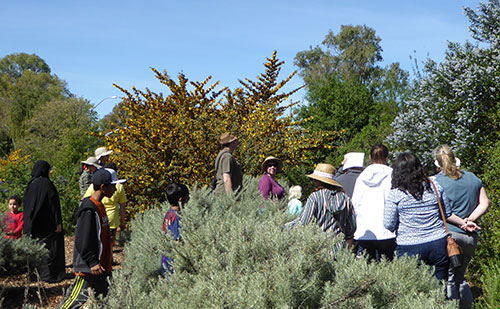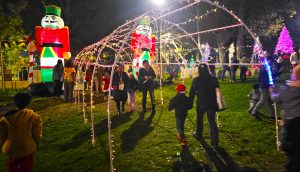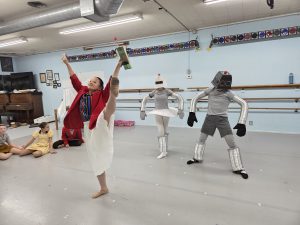Ulistac Natural Area in Santa Clara grows more beautiful and lush with each new spring as established native flower and bush plantings thrive and new plantings take root. Hot orange poppies–California’s state flower since 1903–and a profusion of blue and bright purple ceanothus blossoms and deep yellow flannelbush blossoms were the most colorful attractions for bees, birds, lizards, monarch butterflies and families enjoying Ulistac Wildflower Day April 1.
“The flannelbush is our neon sign for Ulistac,” volunteer Kirsty MacKay told the group she was leading on the 10:15 a.m. wildflower walk. “It’s 42 acres of open space, so once plants are established, we like to leave things alone. We just walk away from the plants and let them grow. When a flower head dies, it adds a point of interest.”
MacKay loaned her magnifying glass to anyone interested in examining the fine hairs on the olive-green leaves of the flannelbush, originally small plants that now tower above heads.
“I saw little hairs and a bud that looked like a yellow strawberry,” said six-year-old Caroline Hill from Mountain View. Her dad, Benjamin Hill, said that the family had found out about Wildflower Day from a Facebook posting.
As well as Ulistac tours, Wildflower Day visitors enjoyed environmental and wildlife education opportunities, children’s crafts and live music under the trees by South Bay Folks (www.southbayfolks.org).
The open space property, formerly a golf course, is owned by the City of Santa Clara, and Ulistac Natural Area Restoration & Education Project (UNAREP) Executive Officer Dennis Dowling oversees the project, which got underway in 2001.
“The City has embraced restoring Ulistac, and we’re overjoyed that we now have the opportunity to continue our restoration,” said Dowling.
He explained that UNAREP was awarded a grant of $206,000 last year from the Santa Clara Valley Water District for restoration work. However, the grant, applied for by the city, comes with a catch–6,500 hours of sweat equity.
By May 2018, volunteers must restore five riparian areas, enhance existing plantings in six areas and upgrade the two ramps leading up to the Guadalupe River trail. The grant money will not be paid to the City until the hours are logged and the projects are completed. Since August 2016, about 700 project hours have been logged.
“This is my backyard. I can get my hands dirty here,” said Santa Clara resident Karen Campbell, originally from Edinburgh, Scotland. “I feel honored to be able to help restore this piece of land, to show people what can be done with drought-tolerant plants.”
Campbell, who has volunteered at Ulistac for the last five years, encourages others to lend a hand.
“No experience is required. We’ll give instructions,” she said. “Please help us to achieve the 6,500 grant hours.”
Campbell pointed out that corporate groups and churches sometimes volunteer as a team-building activity. Regular workdays at Ulistac (4901 Lick Mill Blvd.) are scheduled the first Saturday of the month and the third Sunday. Visit the website for information: www.ulistac.org.












0 comments